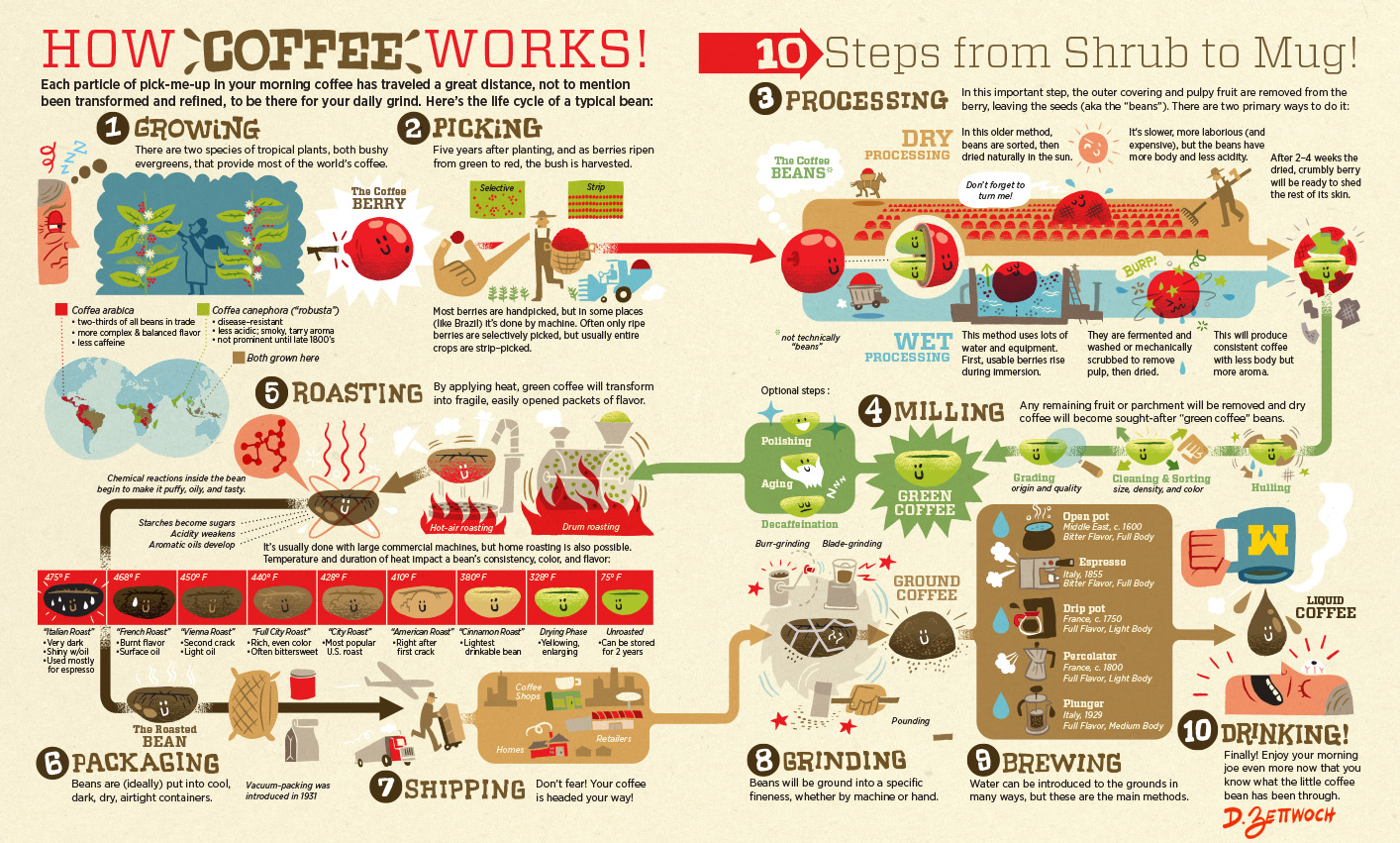How Are Coffee Beans Produced. A great coffee begins with great coffee beans. This section treats the cultivation of the coffee plant. Resting the coffee this way improves its overall shelf life. The coffee cherry has the fruit or pulp removed leaving the seed or bean which is then dried.
 Where Coffee Beans Are Grown OrderCoffeeDelivery
Where Coffee Beans Are Grown OrderCoffeeDelivery From pinterest.com
Where Coffee Beans Are Grown OrderCoffeeDelivery
Where Coffee Beans Are Grown OrderCoffeeDelivery From pinterest.com
More related: Best Drip Coffee Maker - Best Coffee In Lancaster Pa - White Cheswick Block Coffee Table - Frozen Irish Coffee Near Me -
It is not a new development, as brazil has been the highest global producer of coffee beans for over 150 years. On some ivory coast farms, child slaves harvest coffee beans as well as the cacao pods that yield cocoa beans. The majority of the world’s coffee is produced by south. Coffee production is a major source of income for 12.5 million households, most in developing countries. A third of the world’s coffee beans are produced in indonesia; Like brazil nuts (a seed) and white rice, coffee beans consist mostly of endosperm.
Coffee production is the industrial process of converting the raw fruit of the coffee plant into the finished coffee.
Like brazil nuts (a seed) and white rice, coffee beans consist mostly of endosperm. The most common and popular are arabica and robusta, whereas the less common are liberica and excelsa. The solvents that are mostly used are ethyl acetate and methylene chloride. In this process the decaffeinated coffee beans are produced by soaking the beans in a solvent that absorbs the caffeine. There are four different types of coffee beans that are widely produced and sold in the market: Roasted beans are ground and then brewed with near.
 Burundi Fresh Roasted Premium Women Produced Coffee Beans
Source: pinterest.com
Burundi Fresh Roasted Premium Women Produced Coffee Beans
Source: pinterest.com
Cafe copan uses only high grown (hg) beans, grown at an altitude of at least 900 meters (3,000 feet).
 The Journey of The Bean Coffee, Beans and Coffee infographic
Source: pinterest.com
The Journey of The Bean Coffee, Beans and Coffee infographic
Source: pinterest.com
In 2016, brazil produced a staggering 2,592,000 metric tons of coffee beans in 2016.
 BrewBros. Whole Bean Arabica Gourmet Coffee Beans. Single
Source: pinterest.com
BrewBros. Whole Bean Arabica Gourmet Coffee Beans. Single
Source: pinterest.com
The majority of the world’s coffee is produced by south.
 Where Coffee Beans Are Grown CoffeeGifts
Source: pinterest.com
Where Coffee Beans Are Grown CoffeeGifts
Source: pinterest.com
Coffee is grown to produce beans which are used to make a brewed beverage.
 Phone case made from real coffee beans! Real coffee
Source: pinterest.com
Phone case made from real coffee beans! Real coffee
Source: pinterest.com
Each subsequent step of the process has been carefully researched and perfected to minimize the introduction of mold and toxins, which ultimately hinder the performance of.
 Where Coffee Beans Are Grown OrderCoffeeDelivery
Source: pinterest.com
Where Coffee Beans Are Grown OrderCoffeeDelivery
Source: pinterest.com
Coffee production is the industrial process of converting the raw fruit of the coffee plant into the finished coffee.
 The Coffee Map The Bean Belt コーヒー, 地図, デザイン
Source: pinterest.com
The Coffee Map The Bean Belt コーヒー, 地図, デザイン
Source: pinterest.com
The majority of the world’s coffee is produced by south.
 How are coffee beans differentiated? Tea grown in Sri
Source: pinterest.com
How are coffee beans differentiated? Tea grown in Sri
Source: pinterest.com
Brazil is the world�s largest coffee producer.
 Pin on Infographic D*
Source: pinterest.com
Pin on Infographic D*
Source: pinterest.com
While all green coffee is processed, the method that is used varies and can have a significant effect on the flavor of roasted and brewed coffee.
 Amaretto Coffee Bean Massage Bars Coffee beans, Sweet
Source: pinterest.com
Amaretto Coffee Bean Massage Bars Coffee beans, Sweet
Source: pinterest.com
Robusta beans can have up to twice the caffeine as arabica beans, giving the coffee a more bitter taste.
 How to Roast Coffee Beans at Home Made + Remade Coffee
Source: pinterest.com
How to Roast Coffee Beans at Home Made + Remade Coffee
Source: pinterest.com
The dried beans are known as parchment coffee, and are warehoused in jute or sisal bags until they are readied for export.
 Arabica Coffee Plant Coffee plant, Plants, Fast growing
Source: pinterest.com
Arabica Coffee Plant Coffee plant, Plants, Fast growing
Source: pinterest.com
Cafe san marcos supremo uses only strictly high grown (shg) beans, grown at greater than 1,350 meters (4,500 feet).
 Check out how coffee is grown in Colombia in this awesome
Source: pinterest.com
Check out how coffee is grown in Colombia in this awesome
Source: pinterest.com
There’s almost nothing better than the aroma of freshly ground coffee brewing in the morning, and whether you’re after a rich, dark roasted coffee with an intense flavour, or something lighter with zesty notes, there’s plenty of brew to go around.
 How Coffee is Made in 2019 Coffee process, Coffee beans
Source: pinterest.com
How Coffee is Made in 2019 Coffee process, Coffee beans
Source: pinterest.com
The following list of countries by coffee production catalogues sovereign states that have conducive climate and infrastructure to foster the production of coffee beans.
 coffee production infographic Cigar, Coffee and Men
Source:
coffee production infographic Cigar, Coffee and Men
Source:
Resting the coffee this way improves its overall shelf life.
 Coffee Bean Bark made with fresh roasted Oaxacan Yeni
Source: pinterest.com
Coffee Bean Bark made with fresh roasted Oaxacan Yeni
Source: pinterest.com
The solvents that are mostly used are ethyl acetate and methylene chloride.
 Pin on Shade Grown Coffee on Instagram
Source: pinterest.com
Pin on Shade Grown Coffee on Instagram
Source: pinterest.com
In the wet process, lots of water is used to separate the good beans from the bad ones and remove the mucilage that surrounds the bean.
 Berry, bean, sprouted bean, and seedling. Coffee magic
Source: pinterest.com
Berry, bean, sprouted bean, and seedling. Coffee magic
Source: pinterest.com
This section treats the cultivation of the coffee plant.
